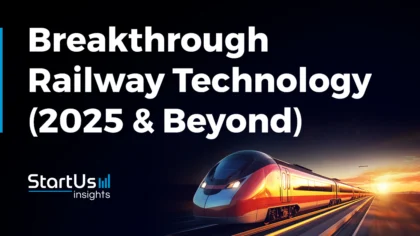Since the first public steam-powered railway was built in 1825, the rail transport industry has been a key component of connecting the world since the Industrial Revolution. Technological innovation has generally been adopted by the rail industry gradually over time.
However, digital technologies such as Automatic Train Control (ATC), Predictive Maintenance, and the Internet of Trains accelerate the speed of innovation. The smart mass transit solutions market is estimated to reach USD 46.36 billion by 2029. Startups and their technologies dramatically contribute to this process as they are the forerunners of innovation.
This article was last updated in July 2024.
Dive into Our Data-driven Railroad Innovation Map
Our Innovation Analysts at StartUs Insights have mapped out the nine most impactful innovation areas for the rail transport industry after analyzing more than 500 startups.
Ready to explore all 500+ Railroad Startups & Scaleups?
Automatic Train Control (ATC)
A train equipped with a GPS-receiver, a camera array and a set of sensors can use an onboard Artificial Intelligence computing unit to become fully autonomous. A network of autonomous trains then is able to communicate with each other and plan speed and route accordingly to avoid interruptions and slow-downs. As a result, autonomous trains have the potential to become the most efficient means of transportation.
Internet of Trains
A large amount of data can be gathered through the Internet of Things (IoT) for analysis and predictive algorism. Constant communication between trains and railroad management systems allows them to coordinate with each other intelligently in order to improve railroad efficiency and safety.
Predictive Maintenance
Predictive Maintenance uses Artificial Intelligence to constantly monitor and analyze data from IoT and other sources. It serves as a continuous inspection and diagnosis function while making accurate predictions on potential failure before it occurs. Predictive Maintenance, therefore, is crucial in reducing maintenance cost, minimizing interruptions, and preventing accidents for a tech-centric railroad system.
Artificial Intelligence (AI)
AI can be adopted in many areas of railroad services. For example, it enables the development of advanced robotics, makes predictions both regarding future traffic and the condition of equipment. Through Artificial Intelligence, railroad operators can predict passenger numbers in advance and plan train capacities and route scheduling accordingly.
Smart Sensors
Smart sensors are the basic building blocks of the Internet of Things. Predictive Maintenance systems utilize smart sensors to gather data and thus monitor every critical component of trains and railroad control systems to predict the potential point of failure in the future.
Looking for specific Railroad Innovation Trends?
Big Data
Essential for railway operations and maintenance, Big Data drives the future of how railroads are designed, planned and operated. Big Data provides means for the efficient real-time monitoring of railroad/traffic conditions and employs advanced data analysis to improve performance and safety measures.
Cloud Computing
Cloud Computing providers secure and distribute repository for rapid access and analysis of big data. In addition, many providers also employ assets, tools or APIs for third-party connectivity for richer functionalities or ease-of-use, so that railroad service providers can focus on optimizing their own operations.
Drones
Drone technology reduces the risk, time, and cost of accessing areas with the workforce and makes the global rail infrastructure safer and more cost effective to maintain, operate and monitor. Working in complementary to a smart sensor system, drones can add layers of data, such as visual, thermal or multispectral data to big data infrastructure.
Biometric Ticketing
Through biometric scans such as facial, fingerprint, retina or voice scans, Biometric Ticketing makes payment, check-in, and seat distribution processes faster and more secure. It also provides an additional layer of identification of customers to improve safety and travel comfort.
Disruptive Startups In The Rail Transport Industry Include:
- OTIV, a Belgian startup, enhances rail safety and efficiency. It develops advanced driver-assistance systems (ADAS) and full self-driving (FSD) solutions for light rail and shunting operations. Leveraging AI, deep learning, computer vision, and sensor technologies, OTIV creates the zero-emission OTIV Light Rail Vehicle System.
- Hitachi Rail improves the efficiency, safety, and quality of fleet management and services through wireless condition monitoring. The startup directly delivers data on assets to improve the end-user experience and plan ahead to make rolling stock available to meet customer demands, maximizing overall safety and efficiency.
- Neuron Soundware works with Artificial Intelligence to detect malfunctioning machines using audio signals. The pre-processing of the input data via a complex physical sensor model allows the neural network to recognize and identify important features with high confidence. The Czech company focuses on the early detection of mechanical malfunctions and offers predictive maintenance, real-time mechanical issue detection, and remote equipment diagnosis.
- Italian IVM develops monitoring systems based on systems of integrated sensors. The startup has vast experience in MEMS (Micro-Electro-Mechanical System) technology accelerometer sensors; hardware and software design as well as the implementation of low-power wireless networks for acquisition systems of accelerometric signals; and the extraction of information-diagnostic content from the data acquired by the monitoring systems through the use of specific processing algorithms.
- Delphisonic supplies big data analytics equipment to carry out measurements and real-time condition monitoring tasks efficiently and securely. The solution, called Real-Time Railway Condition Monitoring, remotely monitors facilities in real-time and detects abnormalities that operators can immediately handle.
- Nexiot develops cloud solutions for smart freight rail sensors. The Swiss startup’s servers and databases provide a secure undistributed repository for rapid access and big data analytics. Their cloud infrastructure is tailor-made and provides all things required to connect assets, including device management tools to Nexiot’s smart sensor as well as other IP based third-party devices through standard interfaces.
- RailPod’s aim is to make the global rail infrastructure safer and more cost effective to maintain, operate and monitor through the use of automated ‘inspection’ drones. The startup’s drones increase the frequency and quality of day-to-day railroad track inspections through advanced sensing technologies and Data-as-a-Service (DaaS).
- Customer Clever strengthens the development of facial recognition technology. The UK-based startup’s solution is smart enough to recognize people who are wearing glasses and cannot be tricked by a photograph, owing to its 3D scanning capabilities. The startup also claims their system is capable of telling apart identical twins.
Explore Emerging Railroad Startups & Technologies
In addition to areas identified above, virtual and augmented reality technologies (VR/AR), machine vision, and light-based communication technologies (LiFi) will help to create a smart and fully automated rail transport system. At StartUs Insights, we provide actionable innovation intelligence on startup-driven innovation to support railroad service companies in accelerating their innovation process and to better adjust their business models to the digital transformation of the industry.










